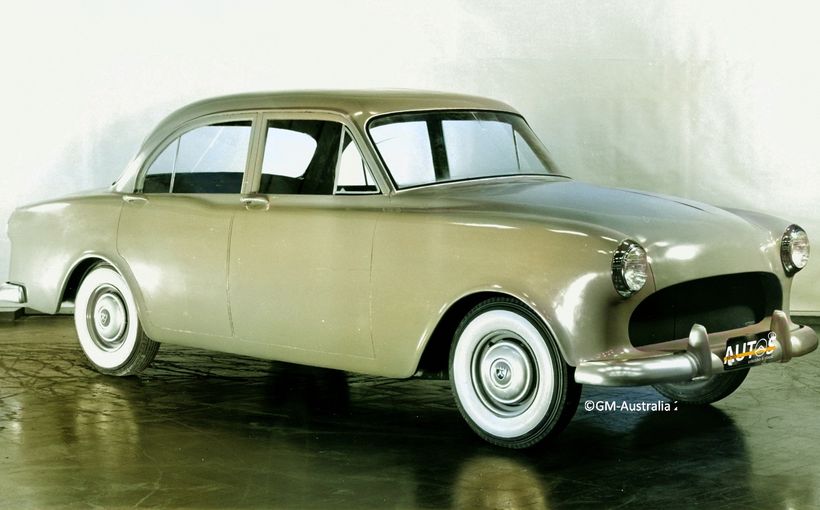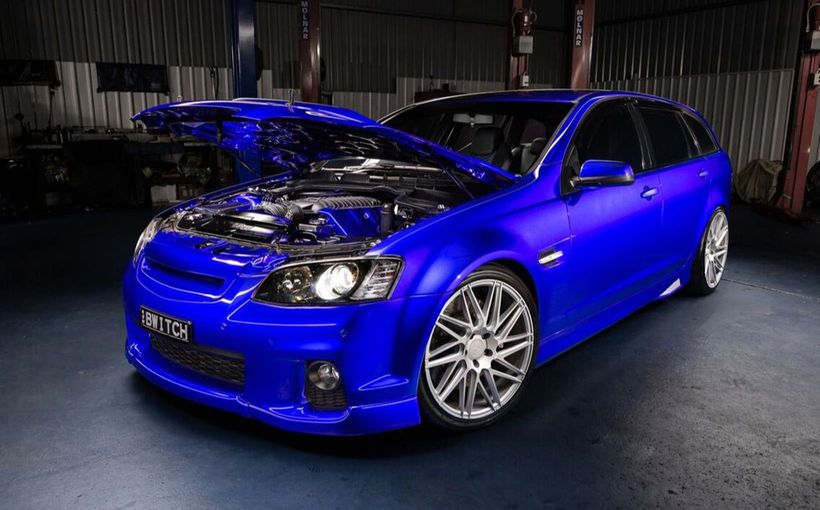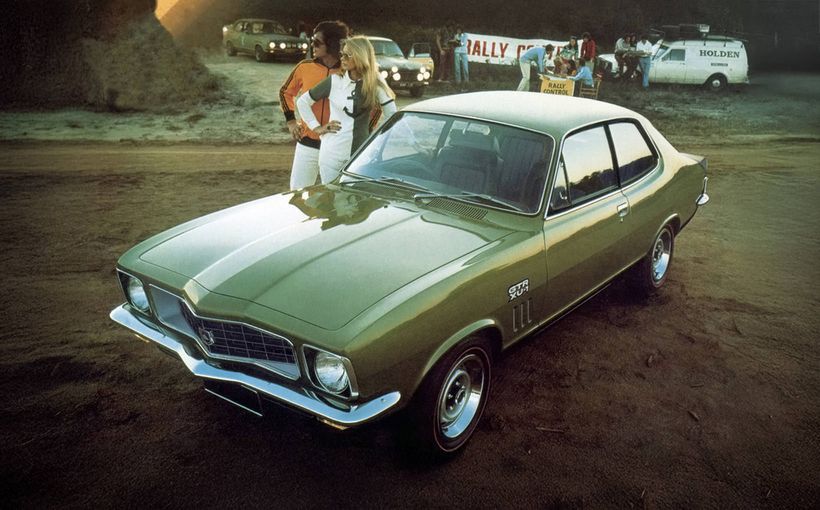Holden VT/VX Commodore: The Most Beautiful Aussie Sedans Ever?

The VT Commodore will go down in history as one of the three or four most important Commodores across what should be thought of as four generations. Indeed, this was the first of the third generation cars. Perhaps it should be considered as one of the true breakthrough Holdens, even more important than, say, the FE (1956, first new-look Holden) and the 1963 EH (with new 100 and 115 brake horsepower ‘red’ engines).
To grasp its significance to the entire Australian motoring industry, the VT needs to be given more context.

November 1978: the VB Commodore arrives as the first truly European-inspired mainstream Holden. By mainstream, I mean the volume-seller, the supposedly ‘full-size’ model, as opposed to a Torana or Gemini. But there is no particular logic to how the Commodore fits into the existing Holden model lineup. Amazingly, both the larger Kingswood/Premier models and the marginally smaller Toranas remain in showrooms: Holden’s marketing heavies are waiting to see how well the Commodore sells. All VBs use carryover six-cylinder and V8 engines. Kingswood/Premiers, Toranas and Commodores are all available with a choice of these engines, making for a huge overlap and a marketing nightmare.
Did any other manufacturer anywhere in the world in 1978 offer three medium to large sedans of completely different exterior and interior design with the choice of six-cylinder or V8 engines? The Torana was also sold as the four-cylinder Sunbird.
Facelifts on the first generation Commodore are VC (1980), VH (1981), VK (1984 and (most importantly) VL (1986) which also introduces the Nissan 3.0-litre single overhead camshaft sixpack to be shared with the Skyline.

August 1988: the so-called ‘Big New V6 Commodore’, the VN ushers in the second generation. For the first time, the Commodore matches or betters the Falcon’s interior dimensions. It uses a lusty, if old-fashioned US-sourced V6 engine. A supercharged version was optional. So was the 5.0-litre V8, upgraded to offer either 179kW or 195.
Facelifts are VP (1991), VR (1993) and VS (1996). The VS is equipped with the upgraded ‘Ecotec’ V6 engine to be used in the forthcoming VT.
What was so special about the VT? Well, the first thing to be said about is that from day one the public loved this sleek machine. So superior to the Falcon was it perceived to be that Ford Australia never again seriously challenged the Commodore’s position as Australia’s top-selling car. When such challenges arrived in the following century, the cars were the Toyota Corolla, Mazda3 and Toyota HiLux. It was the VT that consolidated the Commodore’s ascendancy over the Falcon. Not that all of this was down to Holden because the AU Falcon also played a major part.
Like the VN, the VT began life as an Australianised Opel Omega. Unlike the VN, the finished product shared almost nothing with the German car beyond a broad design theme. Australian designer, Mike Simcoe, who would go on to international fame within General Motors, created what was up to that time undoubtedly the most stylish sedan ever manufactured in this country. The VT made Simcoe’s name, and even though he later designed the VT-based Monaro, it is the sedan that will ultimately be judged the greater achievement).

Here for the first time was a Holden that could bear comparison with a BMW on looks and road stance (and the grille was obviously BMW-influenced, as had been the case since 1993 when the VR introduced its variation of the BMW twin kidneys). There were no obvious compromises in design, as evidenced by the fact that the sporty SS variant came with standard 17-inch wheels, a size that had been the province of HSV models only just a few years earlier. To most observers, the VT was beautiful. But as well as being beautiful, it exuded purpose. Even now, it is difficult to believe how many years have passed since this was Holden’s new car!
No doubt, there are some Holden enthusiasts who would argue that the first series Commodores (1978) had a certain beauty as well. But a key development with VT was that even the entry level car had a really stylish interior as well. For the first time, those who could afford only the least expensive model were not short-changed when it came to features and fabrics.
The VT Executive was designed to appeal not only to fleet customers but also to fussier private buyers. Ford Australia’s marketing team, by contrast, chose the opposite approach to their lasting chagrin: the AU Forte came to market significantly cheaper than a VT Exec, but most of us couldn’t cop the hose-out, cheap feel to the cabin (and that’s before we get started on the exterior detailing!).

So buyers fell in love with the VT. They loved its exterior and interior styling. They loved the solid feeling of quality the car imparted. They loved its ride and handling. Despite the fact that this significantly heavier and safer Commodore used the same 147kW Ecotec engine as its VS predecessor, few owners complained about the slower acceleration. That’s because they were too busy being in love with their cars. It is significant that Holden’s publicity acknowledged that ‘the mass increase of 175kg has resulted in increased acceleration times and fuel consumption over VS’, although the VT ‘continues to provide strong performance and very competitive fuel economy’.
There were unseen virtues, too. The major reason for the Commodore’s weight gain was the much higher level of safety engineered into the car. It was in the early 1990s that work began on the VT, a time when the international automotive industry was more focused on safety than ever before. (The real catalyst for this came in the late 1980s when a leading German magazine began buying its own cars and crash-testing them at high speeds. This forced every major manufacturer to concentrate even more on safety because a bad crash result in Auto, Motor und Sport could only be seriously brand-damaging.)
The VT Executive cost $30,500 at launch with its wagon counterpart at $32,340. Standard equipment was barely credible when judged against the expectations of the VR or VS. Electric height adjustment for the driver’s seat, a rudimentary trip computer and electric windows were all standard. The wagon got a centre lap/sash belt instead of the previous near useless lap belt. But, of course, it wasn’t just the list of standard features but the whole feel of the car: solid, planted, substantial – and of superior quality to any previous Holden.
Next up was the Acclaim, a variant which made its debut with VR. Essentially it was a safety pack and for VR it comprised ABS brakes, independent rear suspension (IRS), driver’s airbag and cruise control, as well as automatic transmission. But much of this marketing cleverness was lost by VT time when IRS and the airbag were standard across the range. The Acclaim cost $33,980 as a sedan and $34,960 as a wagon.
The Berlina name had joined the Commodore lineup with VK back in 1984. This mid-spec version of the VT cost $39,800 as a sedan and $42,600 as a wagon. Automatic, ABS, alloys, fast glass, climate control, cruise control, and many other minor accoutrements were included.
The Calais continued to top the range and was available only as a sedan with the account opening at $48,760. The supercharged six was standard. Much plusher trim (with leather optional), a far better stereo, more electronic wizardry, fog lamps and 16 X 7 alloys were standard.
There were two sporty versions, the $35,550 six-cylinder S and the V8 SS at $44,900. The S was only mildly tweaked with 16-inch alloys, a new bodykit, air-conditioning (as standard equipment), leather steering wheel and ritzier upholstery. But you still got the 179kW sixpack, meaning more show with no more go. By contrast, the SS added 17 X 8 alloys, the 179kW V8, a standard Getrag manual five-slotter, sports (FE2) suspension, limited slip differential, sports seats and. twin airbags.

It is fair to say that the VT Commodore was not quite as good as many people thought. Although the Ecotec V6 was much smoother than it had been back in VN days, it was nevertheless an old-fashioned and coarse unit, in no way to be compared with V6s found in contemporaneous cars such as the Toyota Camry or Mitsubishi Magna.
Yes, it did feature independent rear suspension, but this was a fairly basic arrangement. The control links used by Opel on this semi-trailing arm system were deleted to cut costs. One obvious negative was that when a VT was fully loaded, it sat right down in the rear. There was also some driveline harshness, especially in the V6 cars.
Holden’s Marc McInnes, a former engineer and rally driver who ran the NSW and Queensland public affairs office, was responsible for some of the best press release drives. The Holden system assigned a senior executive to a particular car and the journalists were divided into (colour) teams and cycled through representative cars.
I remember driving one leg with a young engineer beside me. He said he had heard that I drove a Falcon. (It was an EL XR8 manual, considerably improved over standard.) Now, the conventional wisdom among the motoring press was that Commodores were generally superior to Falcons. This bloke was most curious as to why I would choose a Falcon. It actually took me a few seconds to remember the answer, simply because I had long ago ruled a Commodore off my list. At the time I was a triathlete. The Falcon’s split-fold rear seat allowed me to load my racing road bike straight in. But the Commodore only offered a ski-port, which was a deal-breaker for me. This design mistake has been perpetuated in every subsequent Commodore!
The VT was marketed as a driver’s car but its power steering offered little road feel. With wider wheels and sports suspension, the SS was considerably better dynamically.
Then there is the wagon with its hearse-like appearance. Its rear compartment was configured to make it suitable for Telstra. The total result was that the newfound elegance attained by all VT sedans was lost in the load-haulers.

In June 1999 came the first revision to the chart-topping VT with the Series II. The major news was the replacement of the venerable but much loved Aussie 308 with a detuned Gen III Chevrolet 5.7-litre V8. With peak power of 220kW and torque of 446Nm, Gen III offered the promise of significantly more urge. Also, the Executive and SS came standard with a new six-speed manual when specified with the V8. In every other application the Gen III engine was teamed with the already rather dated and clunky Turbo-Hydramatic four-speed automatic.
Visually, VT Series IIs were differentiated by new badging and clear lenses on the side repeater and rear indicators. The exciting new Tiger mica orange livery was immediately popular and was certainly the hero colour for VT Series II SSs. Remote central locking was standardised. There were several other minor changes.

There would be little more than another year before the VX facelift made its debut.
I have already mentioned Mike Simcoe and another key Holden executive of this era who warrants introduction is Laurie Spark, who ran Holden’s safety programs and was a passionate public advocate. Every Holden update seemed to feature bow-tied Sparke (looking every cm the university lecturer) spruiking his safety message. It was Sparke who did great work in ensuring the VT boasted a high degree of frontal impact protection. For the outwardly similar VX he had developed a new upper B-pillar joint along with reinforcement that directed impact forces down towards the feet. New door trims and breakaway door handles completed an extensive improvement in side impact safety. Side airbags had been introduced with VT and were standard on VX Acclaim, Berlina and Calais.
While, of course, there were those who argued that safety shouldn’t be optional, the very fact that the Commodore had moved so far ahead of its nearest rival in side impact safety (which still lacked side airbags until the coming of the BA two years after VX!) is the point that should be stressed. According to Sparke, the risk of injury in a VX not equipped with side airbags was half that of a similar VT. So the modifications which he described as having cost ‘peanuts’ were obviously highly effective.
The VX got modest power increases for both V6 and V8 engines, a neat five kW for each, taking the standard sixpack from 147 to 152kW and the Gen III from 220 to 225kW. But the supercharged six’s peak remained at 171kW.

More importantly, all Commodores got a new driveshaft with rubber couplings at each end. This reduced the driveline harshness which had long been a Commodore gripe. Changes to the front suspension were aimed at making the car a little less sharp in response with more tendency to understeer, albeit certainly not in the manner of the HQ! The overall effect was to make the VX smoother and more refined than its already impressive predecessor.
Crisper frontal treatments clearly differentiated the less expensive Exec, Acclaim, S and SS models from their Berlina/Calais siblings was welcome.

But the loss of the red plastic trim which gave the visual impression of full-width tail lights was a question for the beholder. I, for one, preferred the look of the entry level VT from behind to the VX with its body-coloured bootlid.

In August 2001 the Series II was in Holden showrooms. The biggest news was the addition of extra links to the independent rear suspension to reduce camber change under loads. After four years in the market, the Commodore still felt contemporary and monthly sales were still running sometimes as high as twice the Falcon’s.
The VT and VX Commodores had immense popular appeal which continues even now. Resale values have reflected new car sales, keeping the Commodore significantly ahead of an equivalent Falcon.

These cars have kept a strong following and still look and feel surprisingly fresh. The VT SS on its smart 17-inch alloys set the template for those who like to modify their cars and there have been no shortage of VT and VX customers eager to get their cars riding as low as possible on huge rims and ultra-low profile tyres. It’s no surprise, then, that few standard VT or VX SS Commodores survive. And, of course, V8 Supercar racing has made its own huge contribution to the VT/VX legend.









